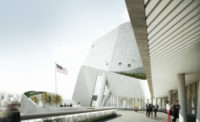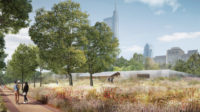Hunter's Point Park Heralds New Era for Queens Waterfront

Hunter's Point South Waterfront Park
Queens, New York
Thomas Balsley Associates
Weiss/Manfredi

Hunter's Point South Waterfront Park
Queens, New York
Thomas Balsley Associates
Weiss/Manfredi

Hunter's Point South Waterfront Park
Queens, New York
Thomas Balsley Associates
Weiss/Manfredi

Hunter's Point South Waterfront Park
Queens, New York
Thomas Balsley Associates
Weiss/Manfredi

Hunter's Point South Waterfront Park
Queens, New York
Thomas Balsley Associates
Weiss/Manfredi

Hunter's Point South Waterfront Park
Queens, New York
Thomas Balsley Associates
Weiss/Manfredi

Queens, New York
Thomas Balsley Associates
Weiss/Manfredi







Hunter's Point South Waterfront Park
Queens, New York
Thomas Balsley Associates
Weiss/Manfredi
The 30-acre swath of Queens known as Hunter's Point South, where the East River meets Newtown Creek, has shed its identity crisis. The property was once slated to become part of Queens West, a vast New York State–sponsored mixed-use development; later, it was the proposed site of the Morphosis-designed athletes’ village for the 2012 Olympics bid.
Then in 2009, the city bought the parcel for $100 million and pledged to fill much of it with middle-income housing. Ground has now been broken for two large apartment buildings, designed by SHoP and Ismael Leyva Architects; together, they will contain 925 “permanently affordable” units.
But the big news is that a 5-acre section of a planned 11-acre park, which will serve as the front lawn for the development (as well as athletic fields for a new FXFOWLE-designed intermediate and high school), has just been completed. “The park got built first, not whittled away by developer interests,” says Michael Manfredi, whose firm, Weiss/Manfredi, teamed with Thomas Balsley Associates on the design of the park. Arup served as prime consultant and infrastructure designer. And superstorm Sandy didn’t throw construction off schedule, which bodes well for the new park’s future. “There was nothing fragile or precious enough to be damaged,” says Balsley of Sandy’s impact, adding that he chose “native plantings that could take a brief bath without consequences.”
The park’s centerpiece, a 1.25-acre green oval, is one of New York’s grandest new public spaces, on an axis with a Deco-era ventilation building for the Queens-Midtown Tunnel, a few hundred feet to the east, and the Empire State Building, just over a mile to the west, across the East River. Swooping around the south side of the oval is a large, bright-white pavilion containing restrooms, maintenance facilities, and (soon to come) a café. Its jaunty, pleated-steel roof reaches toward the sky on angled lally columns. (In its sweep, the building is reminiscent of Weiss/Manfredi’s Brooklyn Botanic Garden visitor center, completed in 2012.)
A dog run on the north side of the oval features a canopy that echoes the larger pavilion. Other park features include a garden built over old railroad tracks, continuing a theme in which new landscapes incorporate industrial castoffs, a move employed by Balsley when he began designing neighboring Gantry Plaza State Park in the 1990s. Another six acres of parkland (and some 4,000 apartments) remain to be built, but already Hunter's Point South is a promising addition to New York City Mayor Michael Bloomberg’s legacy.









